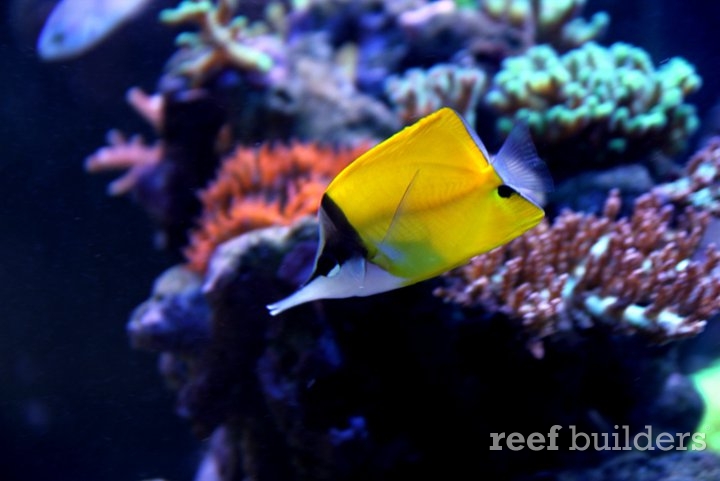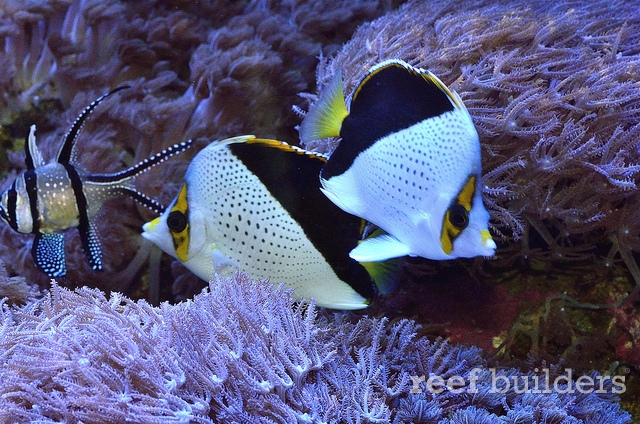Butterflyfish are the quintessential reef inhabitant. Take a look at any coral reef picture, video, documentary, poster, you name it. There’s a high chance a colourful butterfly is flitting around there somewhere.
The same is not to be said in our reef tanks however; butterflyfish, as reefy as they get, are relegated to living in FOWLR systems. Mention a butterflyfish and most reefers will cringe akin to their SPS polyps retracting. Let’s not get too hasty though, as we take a look at some butterflyfish that may be worth trying in your coral tank.

The largest genus of butterflyfish, and the most widespread, is the genus Chaetodon. The bulk of reef inhabiting species that make their living eating off corals as well as frightening would-be butterfly enthusiast. As a general rule of coral keeping, you should avoid all Chaetodon species like the plague. A large portion of this genus are either obligate corallivores, or facultative coralivores. This means that they either rely completely on coral polyps, or include them significantly in their diets.
Butterflies from the Ornate group such as C. ornatissimus, C. reticulatus and C. meyeri are well known untouchables that rely 100% on SPS polyps. On the flip side, the Chaetodon genus also contains a few semi-planktivorous species. Butterflies like C. assarius, G. guentheri, C. dolosus and the likes are often found swimming in mid water, picking floating particles as they float past. These may be worth a try, and i’ve had good success with C. guentheri in reef tanks.
Roaps:

Here’s another group within the Chaetodon genus that are worth a try. The deepwater Roaps butterflies form a subgenus within Chaetodon. These butterflyfish include C. tinkeri, C. mitratus, C. declivis, C. burgess and C. flavocoronatus. All are hardy, and eat almost anything readily in the aquarium. Having kept four out of the five in full-blown reef set ups, I can say with some confidence that they are on the safer side and worth a try if you are willing to take a little risk.
Like Centropyge, some level of risk is to be expected around soft corals and LPS, but I have found them to leave SPS corals alone. Remember, a butterflyfish is ever curious, and they love exploring your tank with their mouths. An occasional harmless nip on your corals are to be expected, but most often than not it is not damaging. Do however, expect less polyp extension on your SPS. In the wild, polyp extensions are usually reserved for feeding at night, and in the day, are kept in check by reef fishes such as, butterflyfish. However if you happen to experience a wayward Roaps that has taken a little to much liking to your coral, then a decision has to be made. Fish, or coral.
Hemitaurichthys:

The genus Hemitaurichthys is sort of like the butterflyfish counterpart to the angelfish genus Genicanthus. Although they do not share the social dynamics of the Genicanthus, they stray away from their main families as pelagic feeders rather than benthic. The pyramid group contains four species – H. polylepis, H. zoster, H. thompsoni and H. multispinosus.
The first two species are the most common and easiest to obtain, and also the most colorful. These are perfectly safe for your reef and enjoy swimming around open waters rather than picking on your favorite Scolymia. As with some examples of freak surgeonfish eating zoanthids, there may be a chance that your pyramid butterflyfish will take a liking to your coral, however remote.
Forcipiger and Chelmon:

This two genera are some of my favorites, with butterflies that possess forcep-like mouths. The genus Forcipiger contains three species. F. flavissimus, F. longirostris and the most recently described F. wanai. Their tiny and delicate mouth parts are not designed for picking at coral polyps, and even your favourite multi colored neon Acanthastrea will scoff at the sight of them.
These long-nosed butterflies are relatively easy to keep, and take frozen foods such as brine and mysis shrimp very readily. They are however, not safe with small benthic creatures such as tube worms, feather worms and most other worms. Having kept these species numerous times, i’d say throw them in your reefs any day.

The same applies to Chelmon. These pointy mouthed butterflies feed mainly on benthic invertebrates and generally show no interest in corals. This genus contains three species – C. marginalis, C. rostratus and C. muelleri. Unlike Forcipiger however, the Chelmon butterflies may take awhile to start feeding and getting used to captive life. This is especially so for C. rostratus, the copperband butterflyfish. Given a healthy one however, they make excellent reef inhabitants and are safer than most Centropyge.

Prognathodes:

The final genus of butterflies worthy of a mention is Prognathodes. Prognathodes butterflies, like the Roaps, are deepwater water members and can be kept in your reef tank with some caution. While not nearly as safe as Forcipiger and Chelmon, these are not necessarily disastrous. Some nipping here and there but usually nothing really serious. Given their rarity and beauty, many fish enthusiasts have given leeway and allowed these fish in their coral tanks. Rightfully so!
The video above by Jeremy Maneyapanda features two Prognathodes (P. aya as well as a P. guyanensis x P. aya hybrid), and a Chaetodon declivis in his reef tank.
This manicured japanese reef tank also features a Prognathodes, this time P. marcellae.
Butterflies are a gorgeous and diverse group of fish. In many ways, certain species such as these shown here are just as, if not safer than many Centropyge and Pomacanthus angels. There are so many examples of angelfish living harmoniously with corals in full blown reefs. It’s not too different with the butterflies too. Leave the bad ones in the FOWLR set ups where their jaws are kept miles away from the nearest coral. Instead, give these safer ones a try. They add a wealth of dimension and character to your tank.



